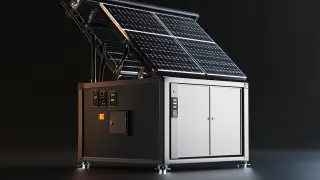



In the past few years, the urgent demand for sustainable energy has boosted the integration of renewable solar energy into systems around the world. An intermittent nature presents its challenge in the application of solar energy, with efficient storage systems garnering massive attention to provide a reliable power supply. Batteries For Storing Solar Electricity, in this respect, assume a critical technology so that consumers and businesses can attain the maximum utilization of solar energy. As the global market is advancing toward cleaner energy, new-footed applications for these battery systems are being considered, further fuelling the vision of a green tomorrow.
Shenzhen Zhesi Lithium Battery Recycling Technology Co., Ltd. finds itself in the forefront of the energy transformation-supporting sustainability in battery technology. Our focus on developing innovative solutions for recycling and repurposing batteries is integrally linked to the rising demand for effective energy storage solutions. Building on the Batteries For Storing Solar Electricity, we expect to make big contributions in the renewable energy landscape-globally delivering goods that enable energy conservation and promote ecological sustainability.

The solar panoramaand storage business ecosystem is presently witnessing an upheaval with innovative technologies and collaborative strategies. Innovative introduction of solar energy solutions such as mobile solar umbrellas and sustainable balcony solar panels has been observed recently and are gaining mass appeal in markets such as Germany. Not only do the solutions promise energy efficiency, but they also democratize access to solar power to the extent that it is being made handy for the consumer and very affordable. In a continuous attempt to enhance the utilization of solar energy, perovskite solar-cell development has now offered a paradigm shift. These third-generation photovoltaic technologies together with advances in silicon-based batteries hold promise in mitigating the variability of solar energy. As countries accelerate their efforts to fulfil their sustainability goals, the challenge lies in integrating innovative solar energy storage with the transformation of the global energy system to clean energy sources.

Solar power, coupled with battery storage, is now changing the energy markets of the globe by providing fantastic efficiencies as well as cost savings. Over the years, battery storage has seen a significant drop in price, making solar and wind and their applications so affordable and available for use by both consumers and businesses. It has become indispensable to countries investing in this technology on the way to a sustainable future for energy.
Major countries such as China, Europe, the USA, and Australia are making great strides in enhancing their battery storage. For instance, large-scale mega projects are under construction to show the seriousness about energy independence in renewables. Also, these store emerge as another way-the virtual batteries are designed for self-consumption in solar energy, whereby users manage to store their energy consumption more efficiently and thereby reduce electricity bills even further. This new development in batteries promotes cleaner energy use with a new possibility of economic opportunities in various industries.

Battery controls have taken on new forms with actual application as energy storage devices for enhancing solar energy. Revolutionary research coming out of Spain has birthed the very first silicon-based solar battery that would ramp up the efficiency of solar energy conversion in molecular storage systems. Breakthroughs like these narrow the gap between producer and consumer because, by solving one of the major problems that come with solar energy production, one can thus more easily give a regular supply of energy and thereby smooth the path to greater use of renewables.
Some work is also done on finding non-conventional materials like volcanic ash for possible use in energy storage devices. Meanwhile, the growth of demand for off-grid energy storage systems worldwide is estimated to be worth over $5.7 billion by 2033; thus, research is focused on cheaper technologies, including underground battery applications. They will thus be very useful movement steps toward sustainable energy storage and significantly replacing fossil fuels in the shift to cleaner energy.

The booming global marketplace for off-grid energy storage systems is characterized by innovative battery solutions. The market is set to exceed $5.71 billion by 2033, growing at a commanding CAGR of 16.45% from 2023 to 2033. The advancements in technology make it possible for households to effectively store solar energy with the introduction of new features that allow batteries to charge only from excess photovoltaic power.
Furthermore, the emergence of virtual batteries is changing the paradigm of how homes and industries use renewable energy. By optimizing self-consumption, these solutions deliver significant savings on future bills and considerably increase the efficiency of solar energy systems. These cutting-edge battery solutions are enhancing energy independence as well as being vital for a sustainable energy transition, as stated with emphasis by the International Energy Agency regarding the capacity to increase global energy storage by six times by 2030.
That is, up until October 2023.
There is increasingly rising solar electricity installations even in the major markets such as California, facing now the quite difficult challenges in the energy grid. This rapid growth of solar energy is imposing distortions in the electricity distribution and transmission systems, thus creating the demand for the most effective remedy. To such challenges, it was found that battery storage could somehow relieve but still not keeping pace with the increasing solar capacity.
For these reasons, many companies are investing millions of dollars for the sake of their battery solutions. This is just for an example in which partnerships with large-scale battery storage with solar projects for optimized and reliable energy management are being deployed. Adoption of such systems is even made more rapidly due to the lowering of prices of batteries, which makes these systems much more affordable both for homeowners and businesses alike. With the world now in the battle for renewable energy as a panacea to climate change, the world must rely on breakthroughs in battery technologies to aggregate solar electricity into markets globally.
The requirements for renewable energy are on the rise, and such advanced battery technologies play an important function in harnessing solar electricity. California, in fact, is leading the race in America, storing more giant energy storage batteries than any other region did after 2020 while ranking just below China worldwide. The advent of battery storage has improved the reliability of solar energy while providing an economical solution to wind and solar generation.
Among recent advances in this field is silicon-based batteries aimed at improving energy conversion efficiency to meet the intermittency demands of solar power. Moreover, modern consumers can already afford household solar battery systems so that they have the capacity to store any overproduced energy generated between sun rays. According to forecasts, solar and battery storage will comprise 81% of new electricity generation in the US by 2024, causing a significant alteration in the scenario of energy consumption.
On a global scale, the decision to adopt batteries for the storage of solar electricity is heavily dependent upon and significantly influenced by the regulatory and economic factors prevalent in the relevant market. Thanks to certain innovations such as the solar charging function of home batteries, more homeowners can now make use of excess photovoltaic energy. This gradual shift is being further backed by regulatory incentives that aim to enhance energy system resilience and promote a transition to renewable energy sources.
The International Energy Agency has identified a global energy storage capacity stretch as one of the most urgent global needs, observing that in the event of doubling renewable energy capacity by 2030, 1,500 GW battery storage would be required. Market competition is active in places like France in particular, where firms are working to improve services to get better market share. Falling battery storage costs allow solar energy providers to economically consider using it, therefore transforming the energy-consumption pattern in the United States, where the installation of large-scale batteries has accelerated.
Battery integration for solar electricity storage is reinventing renewable energy's grid stability. The widespread adoption of solar power means that energy reliability will be vital. New advances in battery technology being pursued in the USA and China are likely to lead to major expansions in energy storage capacity in the near future. This is due to the rise in demand for strong renewable power solutions, along with the expansion of the electric vehicle market.
The advent of virtual batteries is increasing self-consumption options for solar energy, allowing owners and companies to manage their renewable energy more intelligently. Also, energy companies working together are introducing large-scale batteries that stabilize the grid and allow solar power to become economically viable. With decreasing battery prices, they will play an ever-increasing role in sustainable energy and reliability of renewable energy grids.
Energy storage remains to be the greatest beneficiary and the largest developing area in technology in connection with solar energy. Inter-connected solar panels are becoming more widely used. Efficiency uses their collective output. This impending development also raises consciousness of some hidden weaknesses, which have inspired innovators to look for remedies that assure energy reliability and accessibility.
The era of rapidly looking at potential novel storage methods is here, including home batteries for solar power and a virtual scheme for batteries under which users optimize their solar energy consumption. With these new technologies, consumers will be able to not just store energy on-site but also cut costs, making it easier and more effective to manage renewable energy. With growing capacities in battery storage expected across several states, we are laying a good foundation toward a sustainable energy-efficient future.
Storage batteries for solar energy are the subjects of increasing interest among consumers as they develop towards the use of renewable energy sources. Virtual batteries are now revolutionizing self-consumption practices in residences and business premises regarding solar energy. These technologies manage renewable energy at least partly and give value to the investments made in solar energy through financial benefits to the user, for example, future billing discounts.
The new "improvements" in battery technology are quite historical as well. In terms of storage capacity, it is projected that the combined grid storage in Germany will increase considerably soon, which shows how battery storage systems could be important in the ongoing energy transition process. Fresh innovation, like a silicon-based battery or molecular energy storage systems integrated into purpose-built plant architecture, will boost the efficiency of solar energy usage, making it even more attractive to consumers. This revolution mirrors a more general trend towards more sustainable energy solutions that meet consumer requirements and preferences.
Battery storage enhances efficiency and reduces costs, making renewable energy sources like solar more affordable and accessible. It also promotes cleaner energy consumption and creates economic opportunities.
Battery storage costs have decreased dramatically, making it much more affordable for consumers and businesses to adopt renewable energy technologies.
Leading countries include China, Europe, the United States, and Australia, all of which are advancing their battery storage capacities significantly.
A virtual battery allows users to effectively manage their energy usage by optimizing solar self-consumption, ultimately leading to lower electricity bills.
The market for off-grid energy storage systems is projected to surpass $5.71 billion by 2033, with a remarkable CAGR of 16.45% from 2023 to 2033.
Innovative battery solutions enhance energy independence by allowing consumers to store and utilize surplus renewable energy more efficiently.
Remarkable advancements include the development of home solar batteries and virtual battery systems, which will allow more efficient storage and consumption of solar energy.
The International Energy Agency emphasizes the need for expansion to achieve a sustainable energy transition and enhance energy reliability.
By optimizing self-consumption of solar energy, these technologies offer substantial savings on future electricity bills, making renewable energy management simpler.
Interconnected solar panels improve efficiency by harnessing their effective output, prompting innovations that maximize energy reliability and accessibility.





